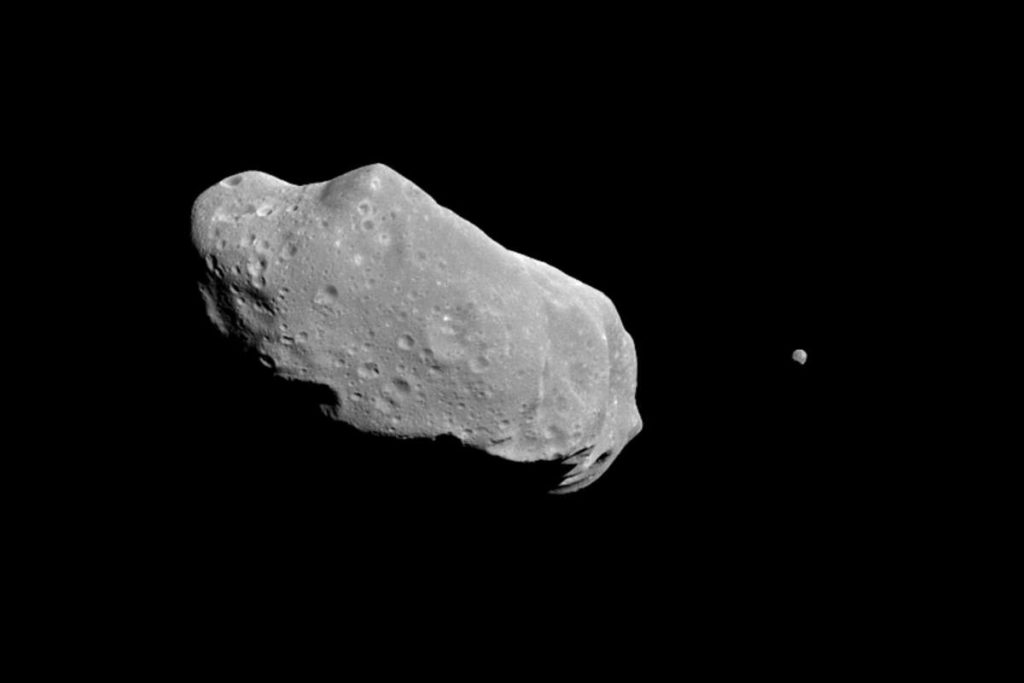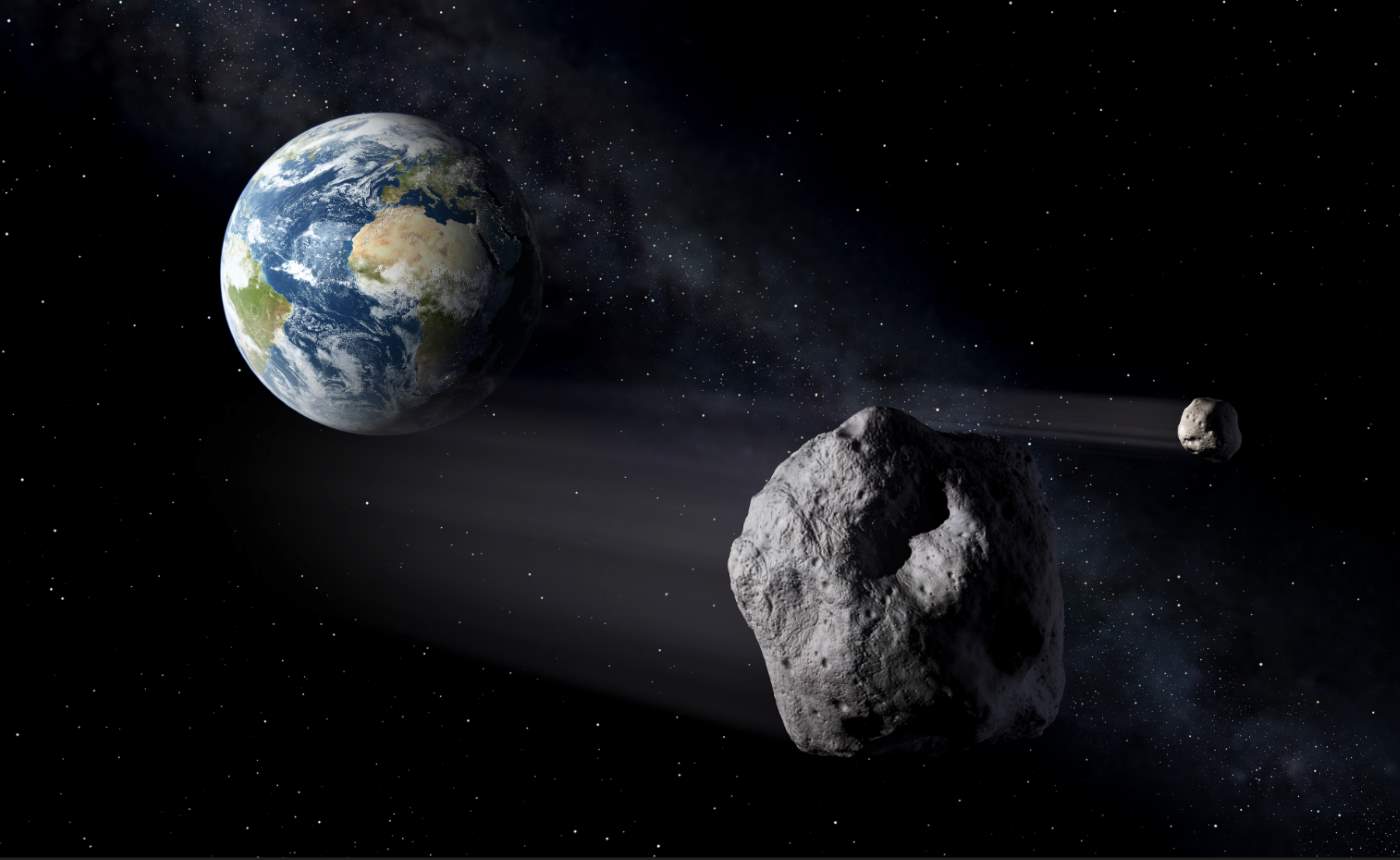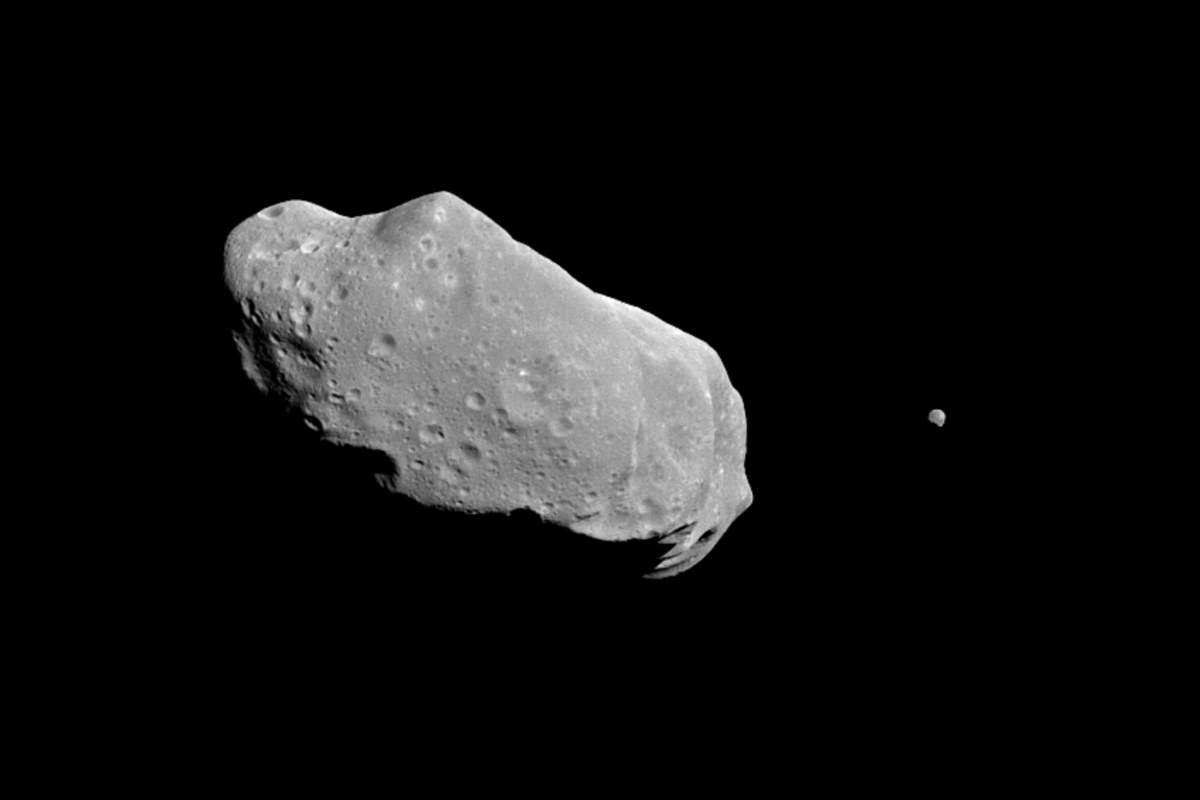On March 23, 1994, a photo was released showing the first moon discovered be in orbit around an asteroid, 243 Ida.
Today’s (March 23) story of what happened this day in Science, Technology, Astronomy, and Space Exploration history.
243 Ida and its small moon Dactyl

On August 28, 1993, Galileo, the second spacecraft encounter with an asteroid obtained an extensive data set on 243 Ida, a small member of the Koronis family of the asteroid belt (see notes 1). Most of the data recorded on the tape recorder returned to Earth in the spring of 1994. The data set has yielded an unprecedentedly high-resolution portrait of 243 Ida and its small moon, the first natural satellite discovered orbiting an asteroid, Dactyl.
243 Ida was discovered on 29 September 1884 by the Austrian astronomer Johann Palisa (6 December 1848 – 2 May 1925) at Vienna Observatory and named after a nymph from Greek mythology by Moriz von Kuffner, a Viennese brewer, and amateur astronomer.
It is a heavily cratered, irregularly shaped asteroid.
243 Ida’s dimensions are 59.8 x 25.4 x 18.6 kilometers (37.1 x 15.8 x 11.6 miles) with a mean radius of 15.7 km (9.8 miles).
Its small moon, Dactyl is only 1.4 kilometers (0.87 mi) in diameter, about 1/20 the size of 243 Ida.
It was previously thought that natural satellites of asteroids could form, but they probably weren’t common. But, after having found one fairly quickly, scientists now think that they’re probably more common than previously thought.
243 Ida’s moon Dactyl was discovered on February 17, 1994, by Ann Harch of the Galileo imaging team. It is the first natural satellite of an asteroid ever discovered and photographed.
Pioneer 10 was the first spacecraft to visit an asteroid
The first spacecraft to visit an asteroid was Pioneer 10, which flew past an unnamed asteroid on August 2, 1972. It was a distant incidental encounter with the closest approach of 8.85 million kilometers (5.5 million miles) while the probe was en route to Jupiter.

Galileo spacecraft
Named after the Italian astronomer, physicist, engineer, philosopher, and mathematician Galileo Galilei (15 February 1564 – 8 January 1642), Galileo was an American robotic space probe that studied the planet Jupiter and its moons, as well as the asteroids Gaspra and Ida.
Consisted of an orbiter and an entry probe, it was delivered into Earth orbit on October 18, 1989, by Space Shuttle Atlantis.
Galileo orbited Jupiter for almost eight years and made close passes by all its major moons. Its camera and nine other instruments sent back reports that allowed scientists to determine, among other things, that Jupiter’s icy moon Europa probably has a subsurface ocean with more water than the total amount found on Earth.
Scientists discovered that the volcanoes of the moon Io repeatedly and rapidly resurface the little world. They found that the giant moon Ganymede possesses its own magnetic field. Galileo even carried a small probe that was deployed and sent deep into the atmosphere of Jupiter, taking readings for almost an hour before the probe was crushed by overwhelming pressure.

The spacecraft was named after Galileo Galilei, because the four largest moons of Jupiter (Io, Europa, Ganymede, and Callisto) were first seen by the Italian astronomer in January 1610, and recognized by him as satellites of Jupiter in March 1610. These four moons are now named “Galilean moons”.
After gravitational assist flybys of Venus and Earth, Galileo arrived at Jupiter on December 7, 1995, and became the first spacecraft to orbit Jupiter.
To eliminate the possibility of contaminating local moons with terrestrial bacteria, on September 21, 2003, after 14 years in space and 8 years in the Jovian system, and after a lot of discoveries, Galileo’s mission was terminated by sending it into Jupiter’s atmosphere at a speed of over 48 kilometers per second (30 miles per second).
Galileo also observed the first extraterrestrial collision of Solar System objects that humanity has witnessed: Comet Shoemaker-Levy 9’s collision with Jupiter in July 1994.
Notes
- The Koronis family, also known as the Lacrimosa family is a very large asteroid family of stony asteroids, located in the outer region of the main asteroid belt between Mars and Jupiter.
Sources
- 243 Ida on Wikipedia
- 243 Ida on the NASA Solar System website
- Galileo (spacecraft) on Wikipedia
- Asteroid Ida and Its Moon on the NASA Jet Propulsion Laboratory (JPL) website
- Galileo misson overview on the NASA Solar System website
- List of missions to minor planets on Wikipedia
- Moon Landings: All-Time List [1966-2025] - February 2, 2025
- What Is Max-Q and Why Is It Important During Rocket Launches? - January 16, 2025
- Top 10 Tallest Rockets Ever Launched [2025 Update] - January 16, 2025
